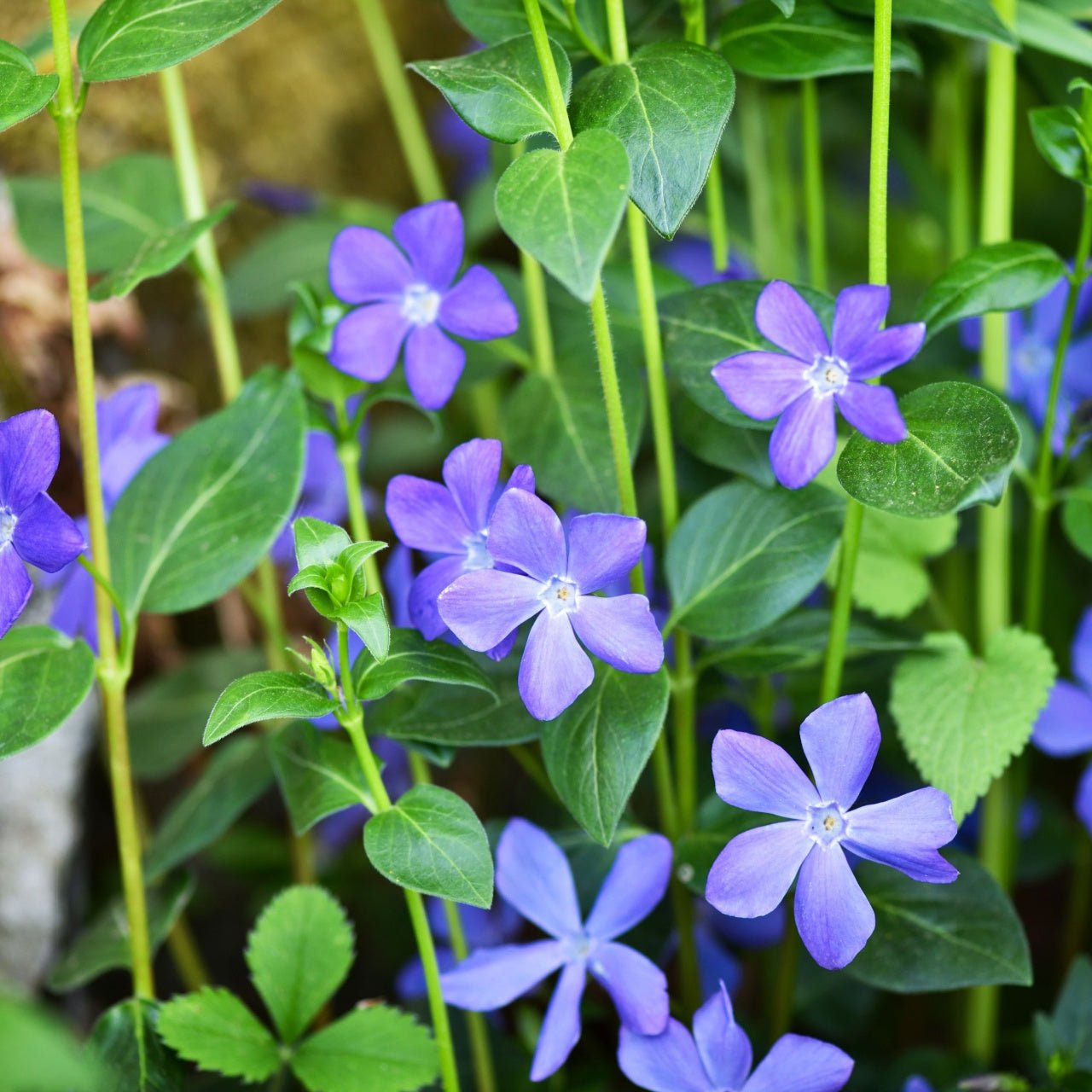What makes your garden even more beautiful?
Your garden may become more exciting when bees, birds, and butterflies appear. Planting flowers with these elements in mind will attract these species and animals, as they are frequently attracted to plants that have pollen, nectar, or seeds.

Vinca minor, also known as Common periwinkle or Creeping myrtle, is a famous groundcover plant used in landscaping and gardening for decades. It is aesthetically pleasing and has various environmental benefits that make it an ideal choice for eco-conscious gardeners. Another environmental advantage of Vinca Minor is its ability to improve soil health. As a groundcover plant, it helps to protect the soil from erosion.
In this article, we will discuss Vinca Minor's benefits, how to grow and care for it and garden design ideas for incorporating it into your landscape.
Environmental Benefits of Vinca Minor
Vinca Minor is an excellent choice for an eco-friendly groundcover due to its numerous advantages. One of the most significant benefits of Vinca Minor is its ability to reduce soil erosion. Its thick foliage helps to anchor the soil in place, preventing it from washing away during heavy rainfalls. This is especially important in sloped areas where runoff is a significant concern.
Another benefit of Vinca Minor is its ability to suppress weed growth. Its dense growth habit prevents sunlight from reaching the soil, making it difficult for weeds to grow. This means that Vinca Minor can reduce the need for chemical herbicides that can be harmful to the environment.
Vinca Minor also provides a habitat for wildlife. Its dense foliage shelters small animals such as chipmunks, rabbits, and birds. The plant's attractive blue-purple flowers also attract bees and butterflies, making it an excellent addition to any wildlife garden.
Vinca Minor is a low-maintenance ground cover that does not require excessive watering or chemicals. Thus, it is an environmentally sustainable option for maintaining a beautiful landscape.
Vinca Minor - The Low-Maintenance Groundcover
Vinca Minor is an easy-to-grow plant that requires minimal care. It is drought-tolerant, meaning it can survive extended periods of dry weather without wilting or dying. Because of this, it is an excellent choice for regions with limited rainfall or gardeners who want to conserve water.
Here is the list of reasons it's one of the lowest maintenance groundcovers:
- Drought-tolerant: Vinca Minor can survive extended periods of dry weather without wilting or dying. The low water requirement makes it a perfect choice for areas with limited rainfall or gardeners who want to conserve water.
- Resistant to pests and diseases: Vinca Minor is a hardy plant not susceptible to many pests or diseases. This means it does not require frequent spraying of pesticides or fungicides to maintain its health.
- Does not require frequent mowing or trimming: The plant's growth habit is low and dense, so it does not require frequent mowing or trimming to maintain its appearance. This makes it ideal for those who want to reduce the time spent maintaining their landscape.
- Can thrive in poor soil conditions: It can flourish in a variety of soil types, including clay, loam, and sandy soil. It does not require nutrient-rich soil, making it ideal for areas with poor soil quality.
- Self-seeds and spreads quickly: Vinca Minor can spread rapidly and fill bare spots in the landscape. It does not require frequent replanting or additional maintenance to maintain its appearance.
To put it simply, Vinca Minor is a low-maintenance groundcover that is easy to care for and can thrive in various conditions. Its ability to tolerate drought, resist pests and diseases, and spread quickly makes it an ideal choice for those who want to reduce the time and effort spent maintaining their landscape.
How You Can Grow and Care for Vinca Minor
Choosing the right location and soil type is essential for Vinca Minor's successful growth. It prefers light shade to full shade and well-drained soil. This plant can grow in a wide range of soil types, such as clay, loam, and sandy soil. However, it prefers slightly acidic soil between the pH range of 6.0 and 7.5.
When planting Vinca Minor, space the plants 12 to 18 inches apart to allow for their spread. Ensure the soil is moist before planting to prevent the roots from drying. Water the plants regularly in the first growing season to establish their roots. Once planted, Vinca Minor requires minimal watering.
Fertilization is not necessary for Vinca Minor, as it can thrive in poor soil conditions. However, adding organic matter to the soil can help to improve soil quality and provide nutrients to the plant.
Vinca Minor requires minimal pruning and maintenance. However, the plant can spread rapidly and may require occasional thinning to prevent overcrowding. The quickest way to do this is to cut back the stems to their base using pruning shears.
Design Ideas Using Vinca Minor
Vinca Minor is a versatile plant for various landscape designs. Its low-growing habit makes it ideal for edging paths, walkways, and garden beds. It can also fill in bare spots in shaded areas.
One design idea is to combine Vinca Minor with other plants to create a natural-looking ground cover. Hostas, ferns, and heucheras are excellent companion plants for Vinca Minor. They have similar shade requirements and create a visually appealing combination of foliage textures and colors. Similarly, combining Vinca Minor with spring-blooming bulbs such as daffodils or crocuses can add a pop of color to the landscape.
Vinca Minor can also be used to create a green carpet under trees or to cover slopes. Plants like these look great in a natural and lush landscape, along with other low-maintenance plants such as pachysandra and ivy.
For a more formal landscape design, you can use it in conjunction with stone or brick pathways or garden borders. Its dense growth habit can help to soften the edges of hardscaping and create a natural-looking transition between the garden and the hardscape.
Takeaways on the Vinca Minor
It's important to remember that plants play a vital role in our environment; however, some plants are more environmentally friendly than others. And if you are looking for the right ground cover plant, Vinca Minor is an excellent choice for an environmentally friendly ground cover.
It offers several benefits, such as reducing soil erosion, suppressing weed growth, and providing habitat for wildlife. Also, its low-maintenance requirements make it an ideal option for gardeners who want to conserve water and reduce the time spent maintaining their landscape.
Moreover, it is a versatile plant that can be used in various landscape designs. Vinca Minor is a great addition to any landscape, whether as a groundcover to fill in bare spots in shaded areas or to create a green carpet under trees.
So, if you want to add a touch of natural beauty to your garden while being environmentally conscious, consider planting Vinca Minor this season!
Visit our online shop for a wide selection of plants and trees, or come say hi at our store location in Tennessee!
We offer fast shipping nationwide, so you can start transforming your garden today!
If you have any questions about the Vinca Minor or any other plant needs, don’t hesitate to contact us at [email protected], we’d love to hear from you!Read more

From proper site selection and soil preparation to mindful plant choices and diligent maintenance, every step contributes to the overall vitality of the garden. The result is a visually pleasing la...

Spiraea Japonica, also known as Japanese Spirea, is a versatile and hardy flowering shrub that has become a favorite among gardeners worldwide. Its delicate pink, white, or red blooms covering the ...




